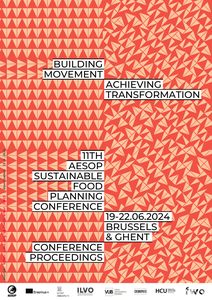Agrobiodiversity has been decreasing substantially in Europe. Social scientific research in this area has paid limited attention to how citizens value agrobiodiversity and its decline, and how these valuations can be influenced. We explore the influence of different arguments for enhancing agro-biodiversity, delivered via short movies, on attitudes and behaviour of students, environmental professionals and people interested in nature conservation in the Netherlands. We conclude that information provision does not influence attitudes. However, it does influence values assigned to agrobiodiversity, but not always in the ways we hypothesized. Information about the intrinsic value of agrobiodiversity has the most effects on values assigned to agrobiodiversity. Among students, women and people with a low emotional attachment with agricultural landscapes (‘place identity’ and ‘place dependence’), emphasizing the instrumental value of agrobiodiversity has a counter-intuitive effect. It does not influence the importance of this value but instead reinforces the intrinsic value they assign to agrobiodiversity. The latter finding is at odds with the instrumental biodiversity discourse in science and policy, which, under headings such as ecosystem services and natural capital, aims to mobilize support for nature conservation by emphasizing its instrumental, functional and economic values. Emphasizing the intrinsic value of agrobiodiversity seems more effective.
LINK
This paper analyses the initiative AgroAgenda in the northern Netherlands. The AgroAgenda is a platform in which multiple stakeholders together stimulate a circular, and nature-inclusive agro-food system in the Dutch provinces of Friesland, Groningen and Drenthe. Stakeholders come from, among others, provincial governments, farmers’ and nature organizations, educational and research institutes and processing companies. They join forces to realize a system change, a transition, in the region, while promoting knowledge circulation, knowledge co-creation and joint learning. The platform, is a front runner of five national, comparable initiatives. The AgroAgenda has the potential to lead to a more nature-inclusive and circular farming. Several of the 40 experiments have already led to good results. However, to bring about a real system change, more attention to innovations in governmental organizations (including law and regulations), policy, the value chains (division of margins, pricing and marketing) and the educational system are needed.
DOCUMENT

Door een opeenstapeling van maatschappelijke, ecologische en politieke crisissen nemen de wensen en eisen die aan de tuinbouwsector gesteld worden hand over hand toe. Aan de andere kant nemen ook de kansen en mogelijkheden door toegenomen kennis en voortdenderende technologische ontwikkelingen rap toe. De tuinbouw verkeert hierdoor in dermate wild vaarwater dat, gezien de veelvoud aan transities, gerust gesproken kan worden van een systeemtransitie. Een systeemtransitie naar een ecologisch en economisch duurzame tuinbouw door productiesystemen die zowel stabiel als hoogproductief zijn, vraagt niet om een vlucht in het verleden, maar om een sprong de toekomst in. Een sprong naar een productiesysteem gebaseerd op kennis van de plant en de interactie met zijn (ecologische) omgeving, ondersteund door hoogwaardige technologie met een hernieuwde vorm van procescontrole. In dit essay onderzoek ik hoe ik als associate lector levende teeltsystemen voor Inholland bij wil dragen aan onderzoek en onderwijs op de actuele transitiepaden van de glastuinbouw. Hoe ik kan bijdragen aan kennis ontwikkeling, nieuwe methoden ontwerpen in onderzoek en deze vertalen naar praktijkgerichte oplossingen. Zo wil ik door samenwerking met collega-onderzoekers en studenten van binnen en buiten Inholland verder invulling geven aan de realisatie van mijn missie. “In onderzoek en onderwijs bijdragen aan een tuinbouwproductiesysteem dat functioneert als een ecosysteem, waarin het samenspel van een grote diversiteit aan levende organismen bijdraagt aan de gezondheid van het productiesysteem en het product dat het produceert. Waarin onze gezamenlijke kennis tot de kunde leidt om levende teeltsystemen als evenwichtige ecosystemen te ontwerpen en te beheren. Waarin telers de biodiversiteit versterken en verzorgen, zodat deze bijdraagt aan de kwaliteitsproductie, in een samenspel van technologie, ecologie en menselijk vernuft. Tuinbouw dus die de wereld van gezonde producten voorziet en in balans is met zichzelf en haar omgeving.”
DOCUMENT

Citizens living in food poverty can easily get caught up in a vicious cycle. Socio-economically disadvantaged people often rely on food assistance and are more likely to suffer from diseases caused by unhealthy diets, such as diabetes. They may also experience isolation and lack social networks, as they do not have the financial means to participate in social life. Moreover, this group is often overlooked in decision-making processes regarding healthy and sustainable food environments. To create equitable food environments in urban areas, it is crucial to incorporate the everyday challenges and needs of socioeconomically disadvantaged people. In our collaborative research, we explore the needs of socioeconomically disadvantaged people regarding a healthy and sustainable diet in Switzerland and the Netherlands. The aim is also to develop, in a participatory way, ideas on how to create more socially just and inclusive food environments.Keywords: food poverty, food environments, social participation, participatory action research
DOCUMENT
